Nighttime Wanderings: Origins, Indications, and Remedies
Sleepwalking, or somnambulism, is a sleep disorder that affects a significant number of people, particularly children and adults with a family history of the condition. This intriguing phenomenon involves walking or performing complex behaviors while still asleep, primarily during deep non-REM sleep.
Most Common Causes
The causes of sleepwalking are multifaceted, with genetics playing a significant role. Sleepwalking tends to run in families, with specific genetic factors linked to the disorder. Other factors that can trigger episodes include sleep deprivation, stress or anxiety, fever, certain medications, coexisting sleep disorders, and neurological issues.
Common Symptoms
Sleepwalking episodes are often marked by nonresponsive behaviors, such as walking, performing routine activities, or even leaving the house. Episodes typically occur during deep non-REM sleep and early in the night. A lack of memory about the episode upon waking is also common.
Treatment Options
For both children and adults, creating a safe sleeping environment is crucial. This involves childproofing the environment to prevent injury during episodes (locking doors/windows, removing sharp objects). Treating any associated sleep disorders, reducing stress, and improving sleep hygiene are also important steps.
In some cases, doctors may prescribe medications to reduce the frequency of sleepwalking, though this is less common and typically for severe cases. Sleepwalking often resolves as children grow older without specific treatment. However, consultation with pediatricians is recommended if episodes are frequent or dangerous.
For adults, treatment may involve medication, relaxation techniques, or hypnosis, depending on the underlying cause and severity of the sleepwalking. In rare or severe cases, referral to a sleep specialist may be necessary.
Additional Notes
It's important to note that sleepwalking episodes generally end with the person returning to sleep without waking fully. Night terrors, occurring mostly in children between ages 3-7, are associated with sudden frightened awakenings without memory of the episode. Awareness and monitoring are key to reducing risks associated with sleepwalking.
One study identified 29 drugs that can trigger sleepwalking, and mental health issues may also play a role, with one study finding that more than 40% of sleepwalkers in the psychiatric population started doing so as adults. Some experts suggest that respiratory problems such as obstructive sleep apnea can contribute to sleepwalking.
On rare occasions, people have been known to drive cars while sleepwalking, which is extremely dangerous. Sleepwalking primarily occurs during non-rapid eye movement (slow-wave) sleep, in the first third of an individual's sleep cycle.
In summary, sleepwalking is primarily caused by genetic and environmental factors influencing deep sleep, shows complex but nonresponsive behaviors during episodes, and is managed by safety precautions, addressing triggers, and medical evaluation when needed. Children often outgrow the disorder naturally, while adults may require more targeted treatment. Taking action to manage sleepwalking behavior can involve preventing sleep deprivation, following a regular sleep schedule, and managing stress through regular exercise.
- Sleep deprivation, stress or anxiety, certain medications, coexisting sleep disorders, neurological issues, and even some drugs like Pfizer's, can block deep sleep and potentially trigger sleepwalking episodes.
- In the health-and-wellness realm, sleepwalking is classified as a sleep disorder, often running in families due to specific genetic factors linked to the condition.
- Science shows that sleepwalking is frequently linked to mental health issues, with more than 40% of sleepwalkers in the psychiatric population having started sleepwalking as adults.
- Given the dangers associated with sleepwalking, such as driving cars while sleepwalking, it's crucial for individuals experiencing this condition to seek advice from healthcare professionals for proper treatment and management.




